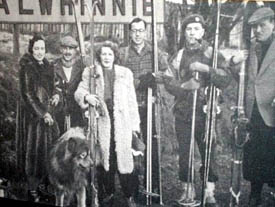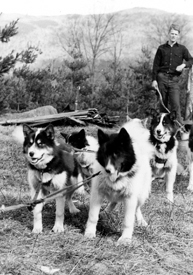From the Editor
Fan Mail
Sled Dogs in His Majesty's Service:
Clark's Eskimo Dogs in World War II
Evolutionary Changes in Domesticated Dogs:
The Broken Covenant of the Wild, Part 3
British Antarctic Survey Sledge Dog
Monument Final Report
Tusaalanga: Learning Inuktitut Online!
In the News
Book Review: The Inuit Thought of It
Tip: Removing Mats
IMHO: The Learning Curve
Index: Volume 11, The Fan Hitch
Navigating
This Site
Index of articles by subject
Index
of back issues by volume number
Search The
Fan Hitch
Articles
to download and print
Ordering
Ken MacRury's Thesis
Our
comprehensive list of resources
Talk
to The
Fan Hitch
The Fan Hitch
home page
ISDI
home page
Editor's/Publisher's Statement
Editor: Sue Hamilton
Webmaster: Mark Hamilton
The Fan Hitch, Journal of
the Inuit Sled Dog, is published four times
a year. It is available at no cost online
at: https://thefanhitch.org.
The Fan Hitch welcomes your letters, stories, comments and suggestions. The editorial staff reserves the right to edit submissions used for publication.
Contents of The Fan Hitch are protected by international copyright laws. No photo, drawing or text may be reproduced in any form without written consent. Webmasters please note: written consent is necessary before linking this site to yours! Please forward requests to Sue Hamilton, 55 Town Line Rd., Harwinton, Connecticut 06791, USA or mail@thefanhitch.org.
This site is dedicated to the Inuit Dog as well as related Inuit culture and traditions. It is also home to The Fan Hitch, Journal of the Inuit Sled Dog.
The Fan Hitch welcomes your letters, stories, comments and suggestions. The editorial staff reserves the right to edit submissions used for publication.
Contents of The Fan Hitch are protected by international copyright laws. No photo, drawing or text may be reproduced in any form without written consent. Webmasters please note: written consent is necessary before linking this site to yours! Please forward requests to Sue Hamilton, 55 Town Line Rd., Harwinton, Connecticut 06791, USA or mail@thefanhitch.org.
This site is dedicated to the Inuit Dog as well as related Inuit culture and traditions. It is also home to The Fan Hitch, Journal of the Inuit Sled Dog.
Click to enlarge image
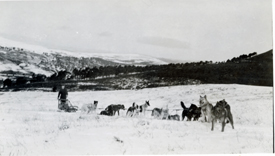
Edward P. Clark’s sled dogs in Scotland in 1943.
Sled is Wonalancet type. Courtesy: W. Murray Clark
Sled Dogs in His Majesty’s Service:
Clark’s Eskimo Dogs in World War II
by Charles L. Dean

Edward P. Clark’s sled dogs in Scotland in 1943.
Sled is Wonalancet type. Courtesy: W. Murray Clark
Sled Dogs in His Majesty’s Service:
Clark’s Eskimo Dogs in World War II
by Charles L. Dean
The British successfully used sled dogs during the Great War in Russia, but there was little use by them during World War II. Essentially the British purchased dogs that were used primarily by the free Norwegians operating in conjunction with them.
When it was thought that a re-invasion of Norway was imminent, there was a scurry of activity among the British staff to plan and equip for an invasion and combat in this Arctic region. It was during this period that planning for the use of sled dogs by the British forces was entertained. After the less than successful Narvik campaign in 1940, the British decided to leave the Arctic fighting and Norway to the free Norwegian troops under British command. An Arctic school was set up in the northern mountains of Iceland in 1941 at Akureyri that was staffed and operated by the Norwegians. Its purpose was training both British and American soldiers in skiing, arctic living and survival, as well as dog team driving.1
As a result of this training experience, a pamphlet was produced by the British War Office in 1943 concerning dog transport. It was only three pages long, and basically echoed what had previously been written in a manual by the U.S. Army and was a very general treatise on sled dog driving and care. Of interest is that the term "Mush" was used as a command.2
By the end of 1943, at least 10,000 allied troops had been trained by the Norwegians in the skills needed for combat and survival in an arctic environment at the Arctic school.3 Sled dogs were used to support these Norwegian troops serving in Iceland and also training in Scotland. One of the latter forces was the Norwegian Independent Company Number 1 (N.I.C.1), also known as the Linge Company, that took part in commando raids into Norway. This unit was under the control of the British Special Operations Executive (S.O.E.), an organization similar to the U.S. Office of Strategic Services (O.S.S.).
Click to enlarge image
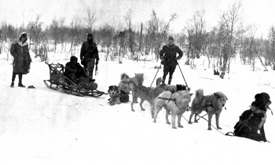
Canadian sled dogs with British North Russia
Expeditionary Force 1918-1919. Courtesy: Mike Jones
The previous April a memo within the S.O.E. considered the "dropping of dogs of the Husky type" by parachute. Coordination between the Special Parachute Section and the Army School of Dogs was requested to study a technique for safe parachute delivery of huskies. It was theorized to use a large wicker laundry type basket similar to those used by the British airborne forces to drop supplies. The dog would be suspended at the top of the basket to reduce the likelihood of the dog breaking its legs. It was also suggested that a "less valuable dog of the mongrel type" instead of a husky be used for the trial drop.6 Norwegian commandos at least experimented with and considered operational plans using sled dogs while in Scotland and under the command of the Special Operations Executive.
Click to enlarge image
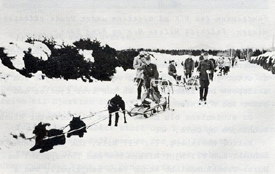
Norwegian army sled dog platoon maneuvers
in 1940. Courtesy: Jan Erik Engebretsen
Click to enlarge image
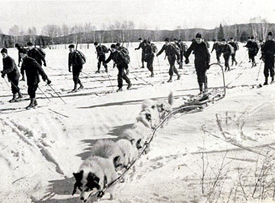
Eskimo Huskies support Norwegian basic ski
instruction at Little Norway, Canada, in WW2
Courtesy: Jan Erik Engebretsen
Their searching eventually led them to Clark's Eskimo Sled Dog Ranch in Lincoln, New Hampshire. The kennel was originally established by Edward P. Clark and Florence P. Clark in 1922 in West Milan, New Hampshire. It was a result of his working in Labrador where he became very impressed with the traits of the Eskimo sled dog breed, particularly their toughness to survive in the harsh arctic land, as well as their ability to pull extremely heavy sled loads all day long. Upon leaving Labrador, he took three dogs with him back to New York and ultimately established his dog ranch (the word kennel was never used by the Clark family) in New Hampshire. They were eventually bred, displayed, raced, and sold as what was then commonly categorized as Eskimo Husky dogs from both Greenland and Labrador. The Clarks became to Eskimo dogs what Milton and Eva Seeley were to Siberian Huskies and Alaskan Malamutes, always trying to promote the breed. The Clarks were in reality a competitor of the Seeleys' Chinook Kennels in Wonalancet, New Hampshire, and were always trying to best their competition. Edward P. Clark's team of Eskimo dogs won the world's championship pulling contest at Madison Square Garden with a load of 4,200 pounds while Mrs. Florence Murray Clark (Edward's wife) was the first woman to drive a sled dog team to the summit of Mount Washington in 1932.9
In the Spring of 1942 Major R.F. Wall, a representative from the British Purchasing Commission in Washington, DC, approached Mr. E.P. Clark inquiring if he could supply twenty-four dogs from his best stock to be delivered to Iceland for war work with the Norwegian government. Major Wall stated that dogs that could pull heavy loads were needed for a secret mission. The dogs were to be assembled in three teams of seven dogs each, along with a spare dog for each team in case any dog became sick, lame, or died.10 These dogs along with harnesses hand made by the Clarks were shipped to Iceland accompanied by Clark's eldest son Edward M. Clark (18 years-old) and George C. Wright11 aboard the S.S. El Coston sailing without escort and rendezvousing at Reykjavik. There, E.M. Clark, dogs, and equipment were transferred to a Norwegian fishing boat and moved north to a point not far from the Arctic Circle.12 These sled dogs and equipment were used by the Norwegians at the Arctic school located in the mountains of northern Iceland for training purposes. After the war, the Clarks received a letter from Leonhard Seppala, a famous Alaskan dog racer, requesting information on their dogs for a Norwegian, Ludvig Sorensen. Apparently Sorensen had been a dog driver of Clark's dogs in both Iceland and Spitsbergen in 1943.13 From Seppala's letter it appears that the dogs used for training in Iceland were also used to support the Norwegian garrison on Spitsbergen as well. After his mission delivering the dogs, Edward M. Clark was offered a position with the U.S. Army as a dog driver in Greenland. He declined the offer, stating that he had been training and driving dog teams since he was a child, and wanted to do something more exciting and challenging. Upon his return to the United States, he became a member of the merchant marine.14
In the fall of 1942, British Major Wall again approached Mr. E.P. Clark and asked him if he could supply forty dogs to ship to Scotland for the British government. The previous sale of twenty-four dogs had depleted the Clark's kennels, and only eight were available at the time. He requested some time to assemble the forty dogs required. At Saranac Lake, New York, he purchased seven Eskimo dogs from Felix Leser. Leser had purchased dogs from Clark previously for his own breeding purposes. Clark's youngest son W. Murray Clark (15 years-old at the time) went to The Pas,
Manitoba, Canada, to select and purchase dogs to make up the number needed for the total. Murray was told to purchase young, strong, and trained dogs that could pull. These sled dogs were crated and shipped by train with Murray riding in the baggage car with them to Clark's dog ranch to be integrated with the other purchases. They were then to be transported to Scotland via ship.15 Accompanying young Murray were two Canadian soldiers, Sergeants James Bingham and Russel Rowe, of the Provost Corps.16 Although these soldiers had no previous dog driving or dog care skills, they were assigned to assist Murray with the dogs. Murray Clark and Sergeants Bingham and Rowe accompanied by the forty dogs, hand made leather harnesses (not the U.S. Army Siwash types), three new sleds, frozen horse meat for the journey, carpenter's tools, and vet supplies set sail in a convoy for England on 29 January, 1943.17
Prior to embarkation, the ship's captain put Murray in charge of not only the dogs, but the two Canadian sergeants as well. The Captain told him that they were going on a very dangerous mission through submarine infested waters and would be at sea for many days. He also stated that should the ship be torpedoed, the dogs were to be killed in their crates as they could not be allowed to be freed and swim around, possibly interfering with the saving of human lives in lifeboats.18
The dogs were exercised on deck while on board ship with the assistance of twenty British soldiers who were returning from escorting enemy prisoners of war to the United States. Dogs were not only walked, but pulled weights in seven dog teams as well.19 In the beginning dogs became somewhat seasick, but after getting their "sea legs" had little trouble with illness.20 Upon arrival at their destination, the dogs were inspected by a British army veterinarian who was very pleased with their good condition. He had expected the dogs to be in bad health along with a few dead ones.21
Click to enlarge image
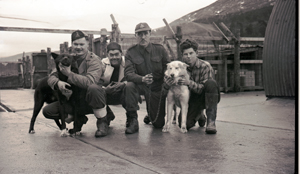
Canadian soldiers and Murray Clark (right) in
Scotland 1943. Courtesy: W. Murray Clark
Click to enlarge image
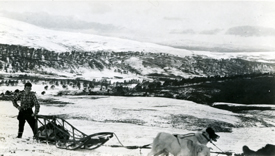
Murray Clark (16 years-old) with Wonalancet sled,
Scotland, 1943. Courtesy: W. Murray Clark
Click to enlarge image
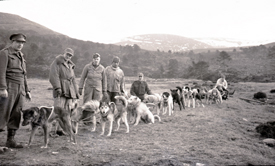
Clark's sled dogs with drag weight, Scotland, 1943.
Courtesy: W. Murray Clark
Click to enlarge image
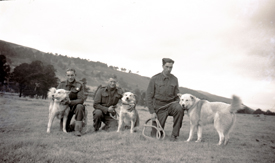
Canadian dog drivers with Clark's Eskimo dogs.
Note harness. Courtesy: W. Murray Clark
Click to enlarge image
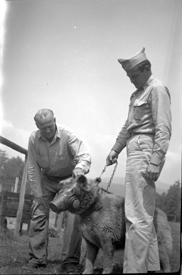
Edward P. Clark fitting dog gas
mask on Eskimo Husky in 1944.
Courtesy: W. Murray Clark
1Barry Gregory, Mountain and Arctic Warfare: From Alexander to Afghanistan ( Wellingborough, Eng.: Patrick Stephens, 1989), 142.
2 Operations in the Snow, Appendix J, "Dog Support", (London, England: The War Office, December, 1943).
3 Gregory, Mountain Warfare, 143.
4 John MacDonald, Glenmore, Aviemore, Inverness-shire, 3 May 1943, letter to Major Hampton.
5 Lt. COL. J.S. Wilson, JSW/1013, 25 May 1943, communication to Captain Tronstad.
6 S.O.E. Memo, "Dropping Dogs from the Air", April 1943, 152.
7 Jan Erik Engebretsen, e-mail to author, September 10, 2006.
8 Jan Erik Engebretsen, e-mail to author, date unknown.
9 W. Murray Clark, interview and transcript by Mark and Sue Hamilton, Lincoln, New Hampshire, September 13, 2000, 1-5.
10 Edward M. Clark, May, 8, 2004, Lisbon, NH, letter to Bjarne Grönnevik
11 Major R.F. Wall, Washington , DC, nd, to The Officer in Charge of Huskies.
12 E.M. Clark, letter.
13 Leonhard Seppala, Seattle, Washington, June 17, 1952, letter to Mr. Edward Clark.
14 E.M. Clark, letter.
15 Murray Clark, interview, September 13, 2000, 7-8.
16 W. Murray Clark, video interview by Maureen Clark, Lincoln, New Hampshire, 2007.
17 W. Murray Clark, Diary, January 29, 1943.
18 Murray Clark, interview. September 13, 2000, 8.
19 W. Murray Clark, "Daily Report on Condition of Dogs", February 5, 1943.
20 W. Murray Clark, Diary, January 30, 1943.
21 W. Murray Clark, Diary, February 14, 1943.
22 W. Murray Clark, Diary, February 15, 1943.
23 Murray Clark, video interview, 2007.
24 W. Murray Clark, Diary, March 15, 1943.
25 Murray Clark, video interview, 2007.
26 Murray Clark, video interview, 2007.
27 W. Murray Clark, Diary, February 17, 1943.
28 W. Murray Clark, Diary, February 16, 1943.
29 Murray Clark, interview, September 13, 2000, 8.
30 Murray Clark, video interview, 2007.
Ed: The following image was found on a display wall in a small museum at the top of the CairnGorm Ski Slope in Aviemore, Scotland. There is a man in a military uniform and the dog appears to be an Inuit Dog. Unfortunately no more information about this photo was ever made available.
